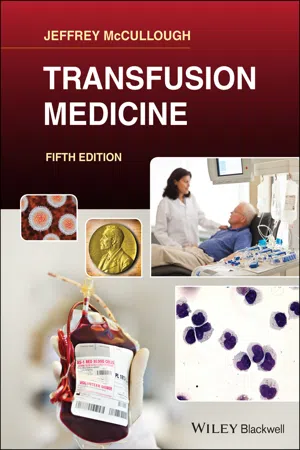
- English
- ePUB (mobile friendly)
- Available on iOS & Android
Transfusion Medicine
About this book
Explore this concise and clinically focused approach to the field of blood banking and transfusion therapy
TheFifth Edition of Transfusion Medicine deliversa succinct, thorough, clinically focused, practicaland authoritative treatment of a full range of topics in transfusion therapy.Thisranges fromissues with the blood supply, recruitmentof both whole blood and apheresis donors, blood collection and storage, blood testing, blood safety, andtransmissible diseases.This edition has been fully updated and revised to include exciting cellular therapies for cancer, transplantation of both hematopoietic cells and solid organs, infectiousdiseasesand regenerative medicine.
TheFifthEditionincludes newauthors with highly relevant content that provides a solid grounding for readers in the field. The book:
- Is an approachable comprehensive guide to the field of blood banking and transfusionmedicine
- Provides complete andtimely perspectiveoncrucialtopics, including the HLA system in transfusion medicine and transplantation and quality programs in blood banking and transfusion medicine
- Isextensively referenced, making it simple for readers to conduct further research on the topics of interest to them
- Includes new chapterson pediatric transfusion medicineand pathogenreduction
- Has an expended chapter on patientblood management
- Provides extensive discussions of the clinical use of blood transfusion in a wide variety of clinical situations including recentdevelopmentInthe management of acute traumatic blood loss
- Provides updatedinformation about blood groups and molecular testing making inroads into clinical practice along withdiscussionsoflaboratory detection of blood groups and provision of redcells
Perfect forall thoseworking in the field of blood banking, transfusionmedicineand hematology or oncologyandfellowsin pathology, hematology, surgeryand anesthesiology. Transfusion Medicine is a good introduction fortechnologists specializing in blood bankingand non-medical personnel working in areas related to hematology and transfusion medicine.Transfusion Medicinewill also earn a place in the libraries of practicing pathologists with responsibilityforbloodbanks.
Frequently asked questions
- Essential is ideal for learners and professionals who enjoy exploring a wide range of subjects. Access the Essential Library with 800,000+ trusted titles and best-sellers across business, personal growth, and the humanities. Includes unlimited reading time and Standard Read Aloud voice.
- Complete: Perfect for advanced learners and researchers needing full, unrestricted access. Unlock 1.4M+ books across hundreds of subjects, including academic and specialized titles. The Complete Plan also includes advanced features like Premium Read Aloud and Research Assistant.
Please note we cannot support devices running on iOS 13 and Android 7 or earlier. Learn more about using the app.
Information
1
History
1.1 Ancient times
1.2 The period 1500–1700
Let there be a young man, robust, full of spirituous blood, and also an old man, thin, emaciated, his strength exhausted, hardly able to retain his soul. Let the performer of the operation have two silver tubes fitting into each other. Let him enter the artery of the young man, and put into it one of the tubes, fastening it in. Let him immediately open the artery of the old man and put the female tube into it, and then the two tubes being joined together, the hot and spirituous blood of the young man will pour into the old one as it were from a fountain of life, and all of this weakness will be dispelled [1].
1.3 The 1800s
Table of contents
- Cover
- Table of Contents
- Title Page
- Copyright Page
- Contributors
- Preface
- 1 History
- 2 The Blood Supply
- 3 Recruitment of Blood Donors
- 4 Blood Donor Medical Assessment, Collection, and Complications
- 5 Preparation, Storage, and Characteristics of Whole Blood, Blood Components, and Plasma Derivatives
- 6 Production of Components by Apheresis
- 7 Laboratory Testing of Donated Blood
- 8 Blood Groups
- 9 Laboratory Detection of Blood Groups and Provision of Red Cells
- 10 Clinical Uses of Blood Components
- 11 Transfusion Therapy in Specific Clinical Situations
- 12 Patient Blood Management
- 13 Pediatric Transfusion Medicine
- 14 Pathogen Reduced Blood Products
- 15 Techniques of Blood Transfusion
- 16 Complications of Transfusion
- 17 Transfusion‐Transmitted Diseases
- 18 The HLA System in Transfusion Medicine and Transplantation
- 19 Cellular Engineering
- 20 Therapeutic Apheresis
- 21 Quality Programs in Blood Banking and Transfusion Medicine
- Index
- End User License Agreement